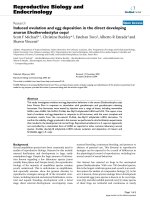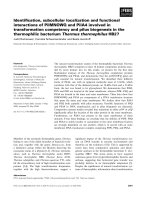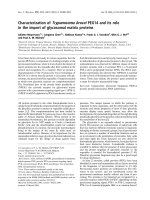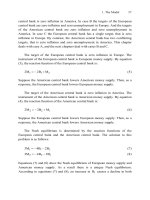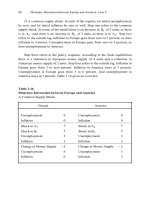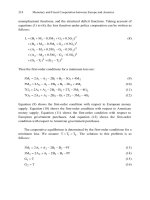Monetary and Fiscal Strategies in the World Economy by Michael Carlberg_4 ppt
Bạn đang xem bản rút gọn của tài liệu. Xem và tải ngay bản đầy đủ của tài liệu tại đây (1.36 MB, 31 trang )
122
2. Some Numerical Examples
For easy reference, the basic model is reproduced here:
111 2
uAG0.5G=−− (1)
222 1
uAG0.5G=−− (2)
111 2
BG0.5Gπ= + + (3)
222 1
BG0.5Gπ= + + (4)
111
sGT=− (5)
222
sGT=− (6)
And the Nash equilibrium can be described by two equations:
11 2
15G 8A 2A 6T=− + (7)
221
15G 8A 2A 6T=−+ (8)
It proves useful to study six distinct cases:
- a demand shock in Europe
- a supply shock in Europe
- a mixed shock in Europe
- another mixed shock in Europe
- a common demand shock
- a common supply shock.
1) A demand shock in Europe. In each of the regions, let initial
unemployment be zero, let initial inflation be zero, and let the initial structural
deficit be zero as well. Step one refers to a decline in the demand for European
goods. In terms of the model there is an increase in
1
A of 3 units and a decline in
1
B of equally 3 units. Step two refers to the outside lag. Unemployment in
Europe goes from zero to 3 percent. Unemployment in America stays at zero
percent. Inflation in Europe goes from zero to – 3 percent. Inflation in America
Fiscal Interaction between Europe and America
123
stays at zero percent. The structural deficit in Europe stays at zero percent, as
does the structural deficit in America.
Step three refers to the policy response. According to the Nash equilibrium
there is an increase in European government purchases of 1.6 units and a
reduction in American government purchases of 0.4 units. Step four refers to the
outside lag. Unemployment in Europe goes from 3 to 1.6 percent.
Unemployment in America goes from zero to – 0.4 percent. Inflation in Europe
goes from – 3 to – 1.6 percent. Inflation in America goes from zero to 0.4
percent. The structural deficit in Europe goes from zero to 1.6 percent. And the
structural deficit in America goes from zero to – 0.4 percent. Table 5.1 presents a
synopsis.
Table 5.1
Fiscal Interaction between Europe and America
A Demand Shock in Europe
Europe America
Unemployment 0 Unemployment 0
Inflation 0 Inflation 0
Structural Deficit 0 Structural Deficit 0
Shock in A
1
3
Shock in B
1
− 3
Unemployment 3 Unemployment 0
Inflation
− 3
Inflation 0
Change in Govt Purchases 1.6 Change in Govt Purchases
− 0.4
Unemployment 1.6 Unemployment
− 0.4
Inflation
− 1.6
Inflation 0.4
Structural Deficit 1.6 Structural Deficit
− 0.4
2. Some Numerical Examples
124
First consider the effects on Europe. As a result, given a demand shock in
Europe, fiscal interaction lowers unemployment and deflation in Europe. On the
other hand, it raises the structural deficit there. Second consider the effects on
America. As a result, fiscal interaction produces overemployment and inflation in
America. And what is more, it produces a structural surplus there. The loss
functions of the European government and the American government are
respectively:
22
111
Lus=+
(9)
22
222
Lus=+
(10)
The initial loss of the European government is zero, as is the initial loss of the
American government. The demand shock in Europe causes a loss to the
European government of 9 units and a loss to the American government of zero
units. Then fiscal interaction reduces the loss of the European government from 9
to 5.12 units. On the other hand, fiscal interaction increases the loss of the
American government from zero to 0.32 units.
2) A supply shock in Europe. In each of the regions let initial unemployment
be zero, let initial inflation be zero, and let the initial structural deficit be zero as
well. Step one refers to the supply shock in Europe. In terms of the model there is
an increase in
1
B of 3 units and an increase in
1
A of equally 3 units. Step two
refers to the outside lag. Inflation in Europe goes from zero to 3 percent. Inflation
in America stays at zero percent. Unemployment in Europe goes from zero to 3
percent. And unemployment in America stays at zero percent.
Step three refers to the policy response. According to the Nash equilibrium
there is an increase in European government purchases of 1.6 units and a
reduction in American government purchases of 0.4 units. Step four refers to the
outside lag. Unemployment in Europe goes from 3 to 1.6 percent.
Unemployment in America goes from zero to – 0.4 percent. Inflation in Europe
goes from 3 to 4.4 percent. Inflation in America goes from zero to 0.4 percent.
The structural deficit in Europe goes from zero to 1.6 percent. And the structural
deficit in America goes from zero to – 0.4 percent. Table 5.2 gives an overview.
Fiscal Interaction between Europe and America
125
Table 5.2
Fiscal Interaction between Europe and America
A Supply Shock in Europe
Europe America
Unemployment 0 Unemployment 0
Inflation 0 Inflation 0
Structural Deficit 0 Structural Deficit 0
Shock in A
1
3
Shock in B
1
3
Unemployment 3 Unemployment 0
Inflation 3 Inflation 0
Change in Govt Purchases 1.6 Change in Govt Purchases
− 0.4
Unemployment 1.6 Unemployment
− 0.4
Inflation 4.4 Inflation 0.4
Structural Deficit 1.6 Structural Deficit
− 0.4
First consider the effects on Europe. As a result, given a supply shock in
Europe, fiscal interaction lowers unemployment in Europe. On the other hand, it
raises the structural deficit there. And what is more, as a side effect, it raises
inflation. Second consider the effects on America. As a result, fiscal interaction
produces overemployment and inflation in America. And what is more, it
produces a structural surplus there. The initial loss of each government is zero.
The supply shock in Europe causes a loss to the European government of 9 units
and a loss to the American government of zero units. Then fiscal interaction
reduces the loss of the European government from 9 to 5.12 units. On the other
hand, it increases the loss of the American government from zero to 0.32 units.
3) A mixed shock in Europe. In each of the regions, let initial unemployment
be zero, let initial inflation be zero, and let the initial structural deficit be zero as
well. Step one refers to the mixed shock in Europe. In terms of the model there is
2. Some Numerical Examples
126
an increase in
1
A of 6 units. Step two refers to the outside lag. Unemployment in
Europe goes from zero to 6 percent. Unemployment in America stays at zero
percent. Inflation in Europe stays at zero percent, as does inflation in America.
Step three refers to the policy response. According to the Nash equilibrium
there is an increase in European government purchases of 3.2 units and a
reduction in American government purchases of 0.8 units. Step four refers to the
outside lag. Unemployment in Europe goes from 6 to 3.2 percent.
Unemployment in America goes from zero to – 0.8 percent. Inflation in Europe
goes from zero to 2.8 percent. Inflation in America goes from zero to 0.8 percent.
The structural deficit in Europe goes from zero to 3.2 percent. And the structural
deficit in America goes from zero to – 0.8 percent. For a synopsis see Table 5.3.
Table 5.3
Fiscal Interaction between Europe and America
A Mixed Shock in Europe
Europe America
Unemployment 0 Unemployment 0
Inflation 0 Inflation 0
Structural Deficit 0 Structural Deficit 0
Shock in A
1
6
Shock in B
1
0
Unemployment 6 Unemployment 0
Inflation 0 Inflation 0
Change in Govt Purchases 3.2 Change in Govt Purchases
− 0.8
Unemployment 3.2 Unemployment
− 0.8
Inflation 2.8 Inflation 0.8
Structural Deficit 3.2 Structural Deficit
− 0.8
Fiscal Interaction between Europe and America
127
First consider the effects on Europe. As a result, given a mixed shock in
Europe, fiscal interaction lowers unemployment in Europe. On the other hand, it
raises the structural deficit there. And what is more, it raises inflation. Second
consider the effects on America. As a result, fiscal interaction produces
overemployment and inflation in America. And what is more, it produces a
structural surplus there. The initial loss of each government is zero. The mixed
shock in Europe causes a loss to the European government of 36 units and a loss
to the American government of zero units. Then fiscal interaction reduces the
loss of the European government from 36 to 20.48 units. On the other hand, it
increases the loss of the American government from zero to 1.28 units.
4) Another mixed shock in Europe. In each of the regions, let initial
unemployment be zero, let initial inflation be zero, and let the initial structural
deficit be zero as well. Step one refers to the mixed shock in Europe. In terms of
the model there is an increase in
1
B of 6 units. Step two refers to the outside lag.
Inflation in Europe goes from zero to 6 percent. Inflation in America stays at zero
percent. Unemployment in Europe stays at zero percent, as does unemployment
in America.
Step three refers to the policy response. According to the Nash equilibrium
there is no change in European government purchases, nor is there in American
government purchases. Step four refers to the outside lag. Inflation in Europe
stays at 6 percent. Inflation in America stays at zero percent. Unemployment in
Europe stays at zero percent, as does unemployment in America. The structural
deficit in Europe stays at zero percent, as does the structural deficit in America.
For an overview see Table 5.4.
As a result, given another mixed shock in Europe, fiscal interaction produces
zero unemployment and a zero structural deficit in each of the regions. The
mixed shock in Europe does not cause any loss to the European government or
American government.
2. Some Numerical Examples
128
Table 5.4
Fiscal Interaction between Europe and America
Another Mixed Shock in Europe
Europe America
Unemployment 0 Unemployment 0
Inflation 0 Inflation 0
Structural Deficit 0 Structural Deficit 0
Shock in A
1
0
Shock in B
1
6
Unemployment 0 Unemployment 0
Inflation 6 Inflation 0
Change in Govt Purchases 0 Change in Govt Purchases 0
Unemployment 0 Unemployment 0
Inflation 6 Inflation 0
Structural Deficit 0 Structural Deficit 0
5) A common demand shock. In each of the regions, let initial unemployment
be zero, let initial inflation be zero, and let the initial structural deficit be zero as
well. Step one refers to a decline in the demand for European and American
goods. In terms of the model there is an increase in
1
A of 3 units, a decline in
1
B
of 3 units, an increase in
2
A of 3 units, and a decline in
2
B of 3 units. Step two
refers to the outside lag. Unemployment in Europe goes from zero to 3 percent,
as does unemployment in America. Inflation in Europe goes from zero to – 3
percent, as does inflation in America.
Step three refers to the policy response. According to the Nash equilibrium
there is an increase in European government purchases and American
government purchases of 1.2 units each. Step four refers to the outside lag.
Unemployment in Europe goes from 3 to 1.2 percent, as does unemployment in
America. Inflation in Europe goes from – 3 to – 1.2 percent, as does inflation in
Fiscal Interaction between Europe and America
129
America. The structural deficit in Europe goes from zero to 1.2 percent, as does
the structural deficit in America. Table 5.5 presents a synopsis.
As a result, given a common demand shock, fiscal interaction lowers
unemployment and deflation in each of the regions. On the other hand, it raises
the structural deficit there. The initial loss of each government is zero. The
common demand shock causes a loss to the European government of 9 units and
a loss to the American government of equally 9 units. Then fiscal interaction
reduces the loss of the European government from 9 to 2.88 units.
Correspondingly, it reduces the loss of the American government from 9 to 2.88
units.
Table 5.5
Fiscal Interaction between Europe and America
A Common Demand Shock
Europe America
Unemployment 0 Unemployment 0
Inflation 0 Inflation 0
Structural Deficit 0 Structural Deficit 0
Shock in A
1
3
Shock in A
2
3
Shock in B
1
− 3
Shock in B
2
− 3
Unemployment 3 Unemployment 3
Inflation
− 3
Inflation
− 3
Change in Govt Purchases 1.2 Change in Govt Purchases 1.2
Unemployment 1.2 Unemployment 1.2
Inflation
− 1.2
Inflation
− 1.2
Structural Deficit 1.2 Structural Deficit 1.2
2. Some Numerical Examples
130
6) A common supply shock. In each of the regions, let initial unemployment
be zero, let initial inflation be zero, and let the initial structural deficit be zero as
well. Step one refers to the common supply shock. In terms of the model there is
an increase in
1
B of 3 units, as there is in
1
A . And there is an increase in
2
B of
3 units, as there is in
2
A . Step two refers to the outside lag. Inflation in Europe
goes from zero to 3 percent, as does inflation in America. Unemployment in
Europe goes from zero to 3 percent, as does unemployment in America.
Step three refers to the policy response. According to the Nash equilibrium
there is an increase in European government purchases and American
government purchases of 1.2 units each. Step four refers to the outside lag.
Unemployment in Europe goes from 3 to 1.2 percent, as does unemployment in
America. Inflation in Europe goes from 3 to 4.8 percent, as does inflation in
America. The structural deficit in Europe goes from zero to 1.2 percent, as does
the structural deficit in America. Table 5.6 gives an overview.
As a result, given a common supply shock, fiscal interaction lowers
unemployment in Europe and America. On the other hand, it raises the structural
deficits there. And what is more, it raises inflation. The initial loss of each
government is zero. The common supply shock causes a loss to the European
government of 9 units and a loss to the American government of equally 9 units.
Then fiscal interaction reduces the loss of the European government from 9 to
2.88 units. Correspondingly, it reduces the loss of the American government
from 9 to 2.88 units.
7) Summary. Given a demand shock in Europe, fiscal interaction lowers
unemployment and deflation in Europe. On the other hand, it raises the structural
deficit there. Given a supply shock in Europe, fiscal interaction lowers
unemployment in Europe. On the other hand, it raises the structural deficit there.
And what is more, as a side effect, it raises inflation. Given a certain type of
mixed shock in Europe, fiscal interaction produces zero unemployment and a
zero structural deficit in each of the regions.
Fiscal Interaction between Europe and America
131
Table 5.6
Fiscal Interaction between Europe and America
A Common Supply Shock
Europe America
Unemployment 0 Unemployment 0
Inflation 0 Inflation 0
Structural Deficit 0 Structural Deficit 0
Shock in A
1
3
Shock in A
2
3
Shock in B
1
3
Shock in B
2
3
Unemployment 3 Unemployment 3
Inflation 3 Inflation 3
Change in Govt Purchases 1.2 Change in Govt Purchases 1.2
Unemployment 1.2 Unemployment 1.2
Inflation 4.8 Inflation 4.8
Structural Deficit 1.2 Structural Deficit 1.2
2. Some Numerical Examples
132
Chapter 2
Fiscal Cooperation
between Europe and America
1. The Model
The model of unemployment, inflation, and the structural deficit can be
characterized by a system of six equations:
111 2
uAG0.5G=−− (1)
222 1
uAG0.5G=−− (2)
111 2
BG0.5Gπ= + + (3)
222 1
BG0.5Gπ= + + (4)
111
sGT=− (5)
222
sGT=− (6)
The policy makers are the European government and the American
government. The targets of fiscal cooperation are zero unemployment and a zero
structural deficit in each of the regions. The instruments of fiscal cooperation are
European government purchases and American government purchases. There are
four targets but only two instruments, so what is needed is a loss function. We
assume that the European government and the American government agree on a
common loss function:
2222
1212
Lu u s s=+++ (7)
L is the loss caused by unemployment and the structural deficit in each of the
regions. We assume equal weights in the loss function. The specific target of
fiscal cooperation is to minimize the loss, given the unemployment functions and
the structural deficit functions. Taking account of equations (1), (2), (5) and (6),
the loss function under fiscal cooperation can be written as follows:
M. Carlberg, Monetary and Fiscal Strategies in the World Economy, 132
DOI 10.1007/978-3-642-10476-3_18, © Springer-Verlag Berlin Heidelberg 2010
133
22
11 2 2 2 1
22
11 2 2
L(A G 0.5G) (A G 0.5G)
(G T ) (G T )
=−− +−−
+− + −
(8)
Then the first-order conditions for a minimum loss are:
11212
9G 4A 2A 4T 4G=++− (9)
22121
9G 4A 2A 4T 4G=++− (10)
Equation (9) shows the first-order condition with respect to European
government purchases. And equation (10) shows the first-order condition with
respect to American government purchases.
The cooperative equilibrium is determined by the first-order conditions for a
minimum loss. We assume
12
TT T
=
= . The solution to this problem is as
follows:
112
65G 28A 2A 20T=++ (11)
221
65G 28A 2A 20T=++ (12)
Equations (11) and (12) show the cooperative equilibrium of European
government purchases and American government purchases. As a result there is
a unique cooperative equilibrium. An increase in
1
A causes an increase in both
European government purchases and American government purchases. A unit
increase in
1
A causes an increase in European government purchases of 0.43
units and an increase in American government purchases of 0.03 units.
Evidently, the cooperative equilibrium is different from the Nash equilibrium.
Put another way, fiscal cooperation is different from fiscal interaction.
1. The Model
134
2. Some Numerical Examples
It proves useful to study two distinct cases:
-
a demand shock in Europe
-
a supply shock in Europe.
1) A demand shock in Europe. In each of the regions, let initial
unemployment be zero, let initial inflation be zero, and let the initial structural
deficit be zero as well. Step one refers to a decline in the demand for European
goods. In terms of the model there is an increase in
1
A of 3 units and a decline in
1
B of equally 3 units. Step two refers to the outside lag. Unemployment in
Europe goes from zero to 3 percent. Unemployment in America stays at zero
percent. Inflation in Europe goes from zero to – 3 percent. Inflation in America
stays at zero percent. The structural deficit in Europe stays at zero percent, as
does the structural deficit in America.
Step three refers to the policy response. What is needed, according to the
model, is an increase in European government purchases of 1.29 units and an
increase in American government purchases of 0.09 units. Step four refers to the
outside lag. Unemployment in Europe goes from 3 to 1.66 percent.
Unemployment in America goes from zero to – 0.74 percent. Inflation in Europe
goes from – 3 to – 1.66 percent. Inflation in America goes from zero to 0.74
percent. The structural deficit in Europe goes from zero to 1.29 percent. And the
structural deficit in America goes from zero to 0.09 percent. Table 5.7 presents a
synopsis.
First consider the effects on Europe. As a result, given a demand shock in
Europe, fiscal cooperation lowers unemployment and deflation in Europe. On the
other hand, it raises the structural deficit there. Second consider the effects on
America. As a result, fiscal cooperation produces overemployment and inflation
in America. And what is more, it produces a structural deficit there. The loss
function under fiscal cooperation is:
2222
1212
Lu u s s=+++
(1)
Fiscal Cooperation between Europe and America
135
The initial loss is zero. The demand shock in Europe causes a loss of 9 units.
Then fiscal cooperation brings the loss down to 4.99 units. Now compare fiscal
cooperation with fiscal interaction. The loss under fiscal cooperation is 4.99
units. And the loss under fiscal interaction is 5.44 units. So, given a demand
shock in Europe, fiscal cooperation seems to be superior to fiscal interaction.
Table 5.7
Fiscal Cooperation between Europe and America
A Demand Shock in Europe
Europe America
Unemployment 0 Unemployment 0
Inflation 0 Inflation 0
Structural Deficit 0 Structural Deficit 0
Shock in A
1
3
Shock in B
1
− 3
Unemployment 3 Unemployment 0
Inflation
− 3
Inflation 0
Change in Govt Purchases 1.29 Change in Govt Purchases 0.09
Unemployment 1.66 Unemployment
− 0.74
Inflation
− 1.66
Inflation 0.74
Structural Deficit 1.29 Structural Deficit 0.09
2) A supply shock in Europe. In each of the regions let initial unemployment
be zero, let initial inflation be zero, and let the initial structural deficit be zero as
well. Step one refers to the supply shock in Europe. In terms of the model there is
an increase in
1
B of 3 units and an increase in
1
A of equally 3 units. Step two
refers to the outside lag. Inflation in Europe goes from zero to 3 percent. Inflation
in America stays at zero percent. Unemployment in Europe goes from zero to 3
percent. And unemployment in America stays at zero percent.
2. Some Numerical Examples
136
Step three refers to the policy response. What is needed, according to the
model, is an increase in European government purchases of 1.29 units and an
increase in American government purchases of 0.09 units. Step four refers to the
outside lag. Unemployment in Europe goes from 3 to 1.66 percent.
Unemployment in America goes from zero to – 0.74 percent. Inflation in Europe
goes from 3 to 4.34 percent. Inflation in America goes from zero to 0.74 percent.
The structural deficit in Europe goes from zero to 1.29 percent. And the
structural deficit in America goes from zero to 0.09 percent. Table 5.8 gives an
overview.
Table 5.8
Fiscal Cooperation between Europe and America
A Supply Shock in Europe
Europe America
Unemployment 0 Unemployment 0
Inflation 0 Inflation 0
Structural Deficit 0 Structural Deficit 0
Shock in A
1
3
Shock in B
1
3
Unemployment 3 Unemployment 0
Inflation 3 Inflation 0
Change in Govt Purchases 1.29 Change in Govt Purchases 0.09
Unemployment 1.66 Unemployment
− 0.74
Inflation 4.34 Inflation 0.74
Structural Deficit 1.29 Structural Deficit 0.09
First consider the effects on Europe. As a result, given supply shock in
Europe, fiscal cooperation lowers unemployment in Europe. On the other hand, it
Fiscal Cooperation between Europe and America
137
raises the structural deficit there. And what is more, as a side effect, it raises
inflation. Second consider the effects on America. As a result, fiscal cooperation
produces overemployment and inflation in America. And what is more, it
produces a structural deficit there. The initial loss is zero. The supply shock in
Europe causes a loss of 9 units. Then fiscal cooperation brings the loss down to
4.99 units. Now compare fiscal cooperation with fiscal interaction. The loss
under fiscal cooperation is 4.99 units. And the loss under fiscal interaction is 5.44
units. So, given a supply shock in Europe, fiscal cooperation seems to be superior
to fiscal interaction.
3) Summary. Given a demand shock in Europe, fiscal cooperation lowers
unemployment in Europe. On the other hand, it raises the structural deficit there.
Given a demand shock in Europe, fiscal cooperation is superior to fiscal
interaction. And the same applies to a supply shock in Europe.
2. Some Numerical Examples
Part Six
Monetary and Fiscal Policies
in Europe and America
Absence of a Deficit Target
141
Chapter 1
Monetary and Fiscal Interaction
between Europe and America
The world economy consists of two monetary regions, say Europe and
America. The monetary regions are the same size and have the same behavioural
functions. An increase in European money supply lowers European unemploy-
ment. On the other hand, it raises European inflation. Correspondingly, an
increase in American money supply lowers American unemployment. On the
other hand, it raises American inflation. An essential point is that monetary
policy in Europe has spillover effects on America and vice versa. An increase in
European money supply raises American unemployment and lowers American
inflation. Similarly, an increase in American money supply raises European
unemployment and lowers European inflation.
An increase in European government purchases lowers European unemploy-
ment. On the other hand, it raises European inflation. Correspondingly, an
increase in American government purchases lowers American unemployment.
On the other hand, it raises American inflation. An essential point is that fiscal
policy in Europe has spillover effects on America and vice versa. An increase in
European government purchases lowers American unemployment and raises
American inflation. Similarly, an increase in American government purchases
lowers European unemployment and raises European inflation.
The model of unemployment and inflation can be represented by a system of
four equations:
111 21 2
uAM0.5MG0.5G=− + −− (1)
222 12 1
uAM0.5MG0.5G=− + −− (2)
11 1 21 2
B M 0.5M G 0.5Gπ= + − + + (3)
22 2 12 1
B M 0.5M G 0.5Gπ= + − + + (4)
M. Carlberg, Monetary and Fiscal Strategies in the World Economy, 141
DOI 10.1007/978-3-642-10476-3_19, © Springer-Verlag Berlin Heidelberg 2010
142
Here
1
u denotes the rate of unemployment in Europe,
2
u is the rate of
unemployment in America,
1
π is the rate of inflation in Europe,
2
π is the rate of
inflation in America,
1
M is European money supply,
2
M is American money
supply,
1
G is European government purchases,
2
G is American government
purchases,
1
A is some other factors bearing on the rate of unemployment in
Europe,
2
A is some other factors bearing on the rate of unemployment in
America,
1
B is some other factors bearing on the rate of inflation in Europe, and
2
B is some other factors bearing on the rate of inflation in America. The
endogenous variables are the rate of unemployment in Europe, the rate of
unemployment in America, the rate of inflation in Europe, and the rate of
inflation in America.
According to equation (1), European unemployment is a positive function of
1
A , a negative function of European money supply, a positive function of
American money supply, a negative function of European government
purchases, and a negative function of American government purchases.
According to equation (2), American unemployment is a positive function of
2
A , a negative function of American money supply, a positive function of
European money supply, a negative function of American government
purchases, and a negative function of European government purchases.
According to equation (3), European inflation is a positive function of
1
B , a
positive function of European money supply, a negative function of American
money supply, a positive function of European government purchases, and a
positive function of American government purchases. According to equation (4),
American inflation is a positive function of
2
B , a positive function of American
money supply, a negative function of European money supply, a positive
function of American government purchases, and a positive function of
European government purchases.
According to the model, a unit increase in European money supply lowers
European unemployment by 1 percentage point. On the other hand, it raises
European inflation by 1 percentage point. And what is more, a unit increase in
European money supply raises American unemployment by 0.5 percentage
points and lowers American inflation by 0.5 percentage points. According to the
model, a unit increase in European government purchases lowers European
unemployment by 1 percentage point. On the other hand, it raises European
Monetary and Fiscal Interaction between Europe and America
143
inflation by 1 percentage point. And what is more, a unit increase in European
government purchases lowers American unemployment by 0.5 percentage points
and raises American inflation by 0.5 percentage points.
To illustrate this there are two numerical examples. First consider an
increase in European money supply.
For instance, let European unemployment
be 2 percent, and let European inflation be 2 percent as well. Further, let
American unemployment be 2 percent, and let American inflation be 2 percent
as well. Now consider a unit increase in European money supply. Then
European unemployment goes from 2 to 1 percent. On the other hand, European
inflation goes from 2 to 3 percent. And what is more, American unemployment
goes from 2 to 2.5 percent, and American inflation goes from 2 to 1.5 percent.
Second consider an increase in European government purchases. For
instance, let European unemployment be 2 percent, and let European inflation be
2 percent as well. Further, let American unemployment be 2 percent, and let
American inflation be 2 percent as well. Now consider a unit increase in
European government purchases. Then European unemployment goes from 2 to
1 percent. On the other hand, European inflation goes from 2 to 3 percent. And
what is more, American unemployment goes from 2 to 1.5 percent, and
American inflation goes from 2 to 2.5 percent.
As to policy targets there are three distinct cases. In case A the target of the
European central bank is zero inflation in Europe. The target of the American
central bank is zero inflation in America. The target of the European government
is zero unemployment in Europe. And the target of the American government is
zero unemployment in America. In case B the targets of the European central
bank are zero inflation and zero unemployment in Europe. The targets of the
American central bank are zero inflation and zero unemployment in America.
The target of the European government is zero unemployment in Europe. And
the target of the American government is zero unemployment in America. In
case C the target of the European central bank is zero inflation in Europe. The
targets of the American central bank are zero inflation and zero unemployment
in America. The target of the European government is zero unemployment in
Europe. And the target of the American government is zero unemployment in
America.
Monetary and Fiscal Interaction between Europe and America
144
1) Case A. The target of the European central bank is zero inflation in
Europe. The instrument of the European central bank is European money supply.
By equation (3), the reaction function of the European central bank is:
11212
2B 2M M 2G G 0+−++= (5)
Suppose the American central bank lowers American money supply. Then, as a
response, the European central bank lowers European money supply. Suppose
the European government raises European government purchases. Then, as a
response, the European central bank lowers European money supply. Suppose
the American government raises American government purchases. Then, as a
response, the European central bank lowers European money supply.
The target of the American central bank is zero inflation in America. The
instrument of the American central bank is American money supply. By
equation (4), the reaction function of the American central bank is:
22121
2B 2M M 2G G 0+−++= (6)
The target of the European government is zero unemployment in Europe. The
instrument of the European government is European government purchases. By
equation (1), the reaction function of the European government is:
11212
2A 2M M 2G G 0−+−−= (7)
The target of the American government is zero unemployment in America. The
instrument of the American government is American government purchases. By
equation (2), the reaction function of the American government is:
22121
2A 2M M 2G G 0−+−−= (8)
Suppose the European central bank lowers European money supply. Then, as
a response, the European government raises European government purchases,
the American central bank lowers American money supply, and the American
government lowers American government purchases. Suppose the European
government raises European government purchases. Then, as a response, the
European central bank lowers European money supply, the American central
Monetary and Fiscal Interaction between Europe and America
145
bank lowers American money supply, and the American government lowers
American government purchases.
The Nash equilibrium is determined by the reaction functions of the
European central bank, the American central bank, the European government,
and the American government. Adding up equations (5) and (7) yields:
11
AB0+= (9)
Adding up equations (6) and (8) yields:
22
AB0+= (10)
This, however, is in contradiction to the assumption that
1
A ,
2
A ,
1
B and
2
B
are given exogenously. As an important result, in case A, there is no Nash
equilibrium.
2) Case B.
The targets of the European central bank are zero inflation and
zero unemployment in Europe. The instrument of the European central bank is
European money supply. There are two targets but only one instrument, so what
is needed is a loss function. We assume that the European central bank has a
quadratic loss function:
22
111
LM u=π + (11)
1
LM is the loss to the European central bank caused by inflation and
unemployment in Europe. We assume equal weights in the loss function. The
specific target of the European central bank is to minimize its loss, given the
inflation function and the unemployment function. Taking account of equations
(1) and (3), the loss function of the European central bank can be written as
follows:
2
111 21 2
2
11 21 2
LM (B M 0.5M G 0.5G )
(A M 0.5M G 0.5G )
=+− ++
+−+ −−
(12)
Monetary and Fiscal Interaction between Europe and America
146
Then the first-order condition for a minimum loss gives the reaction function of
the European central bank:
11 1 2 1 2
AB2MM 2GG 0−− + − − = (13)
Suppose the American central bank lowers American money supply. Then, as a
response, the European central bank lowers European money supply. Suppose
the European government raises European government purchases. Then, as a
response, the European central bank lowers European money supply. Suppose
the American government raises American government purchases. Then, as a
response, the European central bank lowers European money supply.
The targets of the American central bank are zero inflation and zero
unemployment in America. The instrument of the American central bank is
American money supply. There are two targets but only one instrument, so what
is needed is a loss function. We assume that the American central bank has a
quadratic loss function:
22
222
LM u=π + (14)
2
LM is the loss to the American central bank caused by inflation and
unemployment in America. We assume equal weights in the loss function. The
specific target of the American central bank is to minimize its loss, given the
inflation function and the unemployment function. Taking account of equations
(2) and (4), the loss function of the American central bank can be written as
follows:
2
222 12 1
2
22 12 1
LM (B M 0.5M G 0.5G )
(A M 0.5M G 0.5G )
=+− ++
+−+ −−
(15)
Then the first-order condition for a minimum loss gives the reaction function of
the American central bank:
22 2 1 21
AB2MM2GG0−− + − −= (16)
Monetary and Fiscal Interaction between Europe and America
147
The target of the European government is zero unemployment in Europe.
The instrument of the European government is European government purchases.
By equation (1), the reaction function of the European government is:
11212
2A 2M M 2G G 0−+−−= (17)
The target of the American government is zero unemployment in America. The
instrument of the American government is American government purchases. By
equation (2), the reaction function of the American government is:
22121
2A 2M M 2G G 0−+−−= (18)
The Nash equilibrium is determined by the reaction functions of the
European central bank, the American central bank, the European government,
and the American government. Taking the difference between equations (17) and
(13) yields:
11
AB0+= (19)
Taking the difference between equations (18) and (16) yields:
22
AB0+= (20)
This, however, is in contradiction to the assumption that
1
A ,
2
A ,
1
B and
2
B
are given exogenously. As an important result, in case B, there is no Nash
equilibrium.
3) Case C. The target of the European central bank is zero inflation in
Europe. The instrument of the European central bank is European money supply.
By equation (3), the reaction function of the European central bank is:
11212
2B 2M M 2G G 0+−++= (21)
The targets of the American central bank are zero inflation and zero
unemployment in America. The instrument of the American central bank is
American money supply. There are two targets but only one instrument, so what
Monetary and Fiscal Interaction between Europe and America
148
is needed is a loss function. We assume that the American central bank has a
quadratic loss function:
22
222
LM u=π + (22)
2
LM is the loss to the American central bank caused by inflation and
unemployment in America. We assume equal weights in the loss function. The
specific target of the American central bank is to minimize its loss, given the
inflation function and the unemployment function. Taking account of equations
(2) and (4), the loss function of the American central bank can be written as
follows:
2
222 12 1
2
22 12 1
LM (B M 0.5M G 0.5G )
(A M 0.5M G 0.5G )
=+− ++
+−+ −−
(23)
Then the first-order condition for a minimum loss gives the reaction function of
the American central bank:
22 2 1 21
AB2MM2GG0−− + − −= (24)
The target of the European government is zero unemployment in Europe.
The instrument of the European government is European government purchases.
By equation (1), the reaction function of the European government is:
11212
2A 2M M 2G G 0−+−−= (25)
The target of the American government is zero unemployment in America. The
instrument of the American government is American government purchases. By
equation (2), the reaction function of the American government is:
22121
2A 2M M 2G G 0−+−−= (26)
The Nash equilibrium is determined by the reaction functions of the
European central bank, the American central bank, the European government,
and the American government. Taking the sum of equations (21) and (25) yields:
Monetary and Fiscal Interaction between Europe and America

